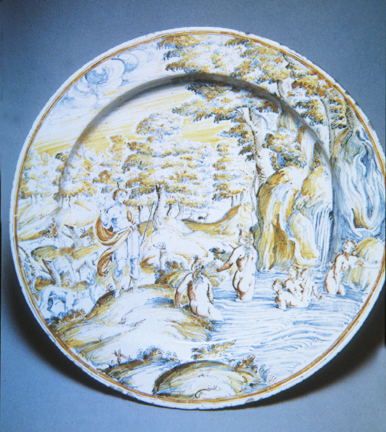Another example of the istoriato style is this large plate from Faenza, probably painted by Stefano Accarisi in 1585. The story of Diana (Artemis to the Greeks) and Acteon has been seen before, and was retold by Ovid in his 'Metamorphoses,' and was one of the most frequently illustrated legends painted by Renaissance majolica painters. Acteon, the young hunter, comes across Diana, bathing with her maidens in a pool. He incurs her wrath and she turns him into a stag. He is terrified and unable to speak, and is set upon by his own dogs, and killed. Note the unusually light palette, with large amounts of the bianchi glaze left unpainted. This style is called the 'compendiario'* style and is distinguished by: 1) a lightly painted and sketched in a restricted palette, and 2) large areas of white left visible. This style is often associated with Faenza.
*The ceramics scholar, G. Ballardini, took the term "compendiario" from archaeology, where it was used to designate a type of Roman painting (pictura compendiaria) which grew up around the end of the 1st century A.C. Its technique of rapid, essential brush strokes reproduced a particular mode in Hellenistic painting, which preceded it.

'Diana and Acteon', Majolica, probably by Stefano Accarisi, Faenza, 1585 CE, 32" d.


